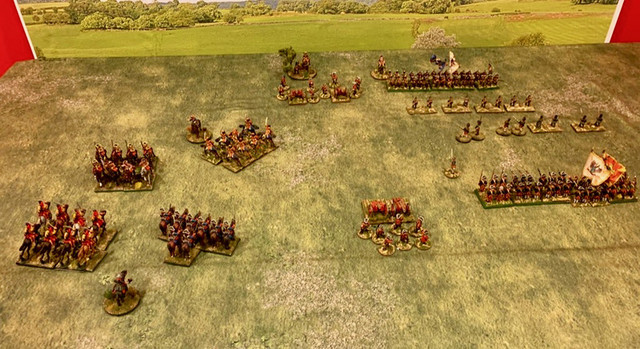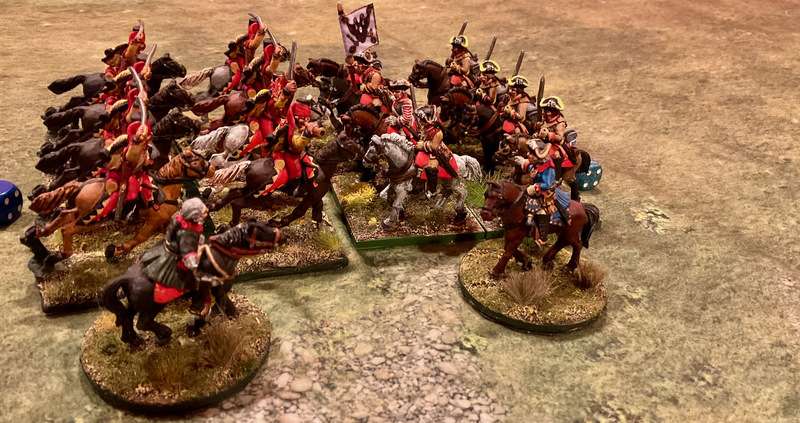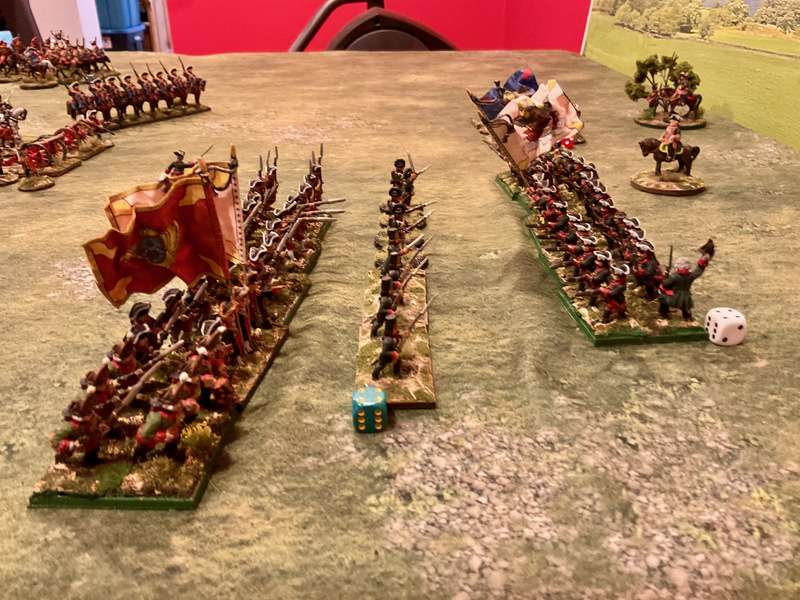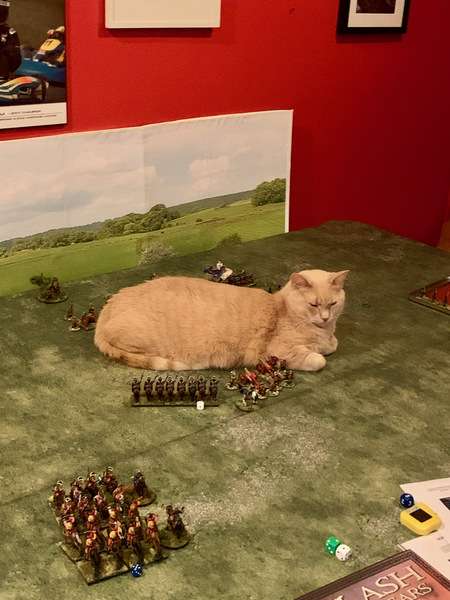Hello friends:
As I’ve said here recently, the SYW painting muse has captured my attention lately, and her sister muse of SYW gaming paid a visit recently. As I’ve been slowly painting Prussians and rebasing a rather old collection of Russians, I’ve been slowly getting to know Keith Flint’s Honours of War SYW rules, published a few years ago by Osprey.

SYW was one of my early gaming loves, and back in the day the group I hung out with had two favourite rules. The grognards all liked Phil Barker’s Wargamer Rules 1685-1845 (WRG), while the young turks preferred Tod Kershner’s Warfare in the Age of Reason rules (Emperor’s Press). Both were hugely influential rules in their day, and I suspect most people would point to Black Powder as their most prominent heir and successor. I confess I’ve only played BP once and didn’t find it terribly compelling, but can’t offer a fair and comprehensive opinion.
I had been following Keith Flint’s wargames blog for some years and so was tracking his own SYW rules and even received a playtest copy, though at the time my life was complex and my gaming time quite limited, so I put it aside, I was also discouraged by the fact that the National Characteristics didn’t include the Ottomans, as for some reason I’d found myself with a Turkish horse and musket army.
Recently I’ve been rebasing my Russian SYW troops from their WRG-era bases and putting everything on standard size bases, since most rules these days seem basing agnostic and I can’t be bothered cutting fancy and precise bases for skirmishers vs heavy cavalry. I sound like a grumpy old git, but there you go. Feeling that I’d made enough progress to get some troops on the table, I divided my Russians into two forces, each of two very small brigades, just to push some figures around and get a feel for the rules.

Clearly wanting to modernize their thinking, the Russian army stages a mock battle on the drill fields outside Moscow. Both sides have a brigade of two horse units, and both have a brigade with two batteries, a light infantry regiment, and a line regiment. All units are rated as Standard and all commanders are rated as Dependable, just to make the test drive easier.
In some of the reviews I’ve read, people don’t like the initiative and command and control,system, and others like it. I'm in the latter camp. I liked the uncertainty of which brigade gets to move first, which breaks up the chess-like feel that SYW games sometimes have. I also liked the fact that an average or good commander might get two moves in a turn, vs another brigade’s none, which introduces a very fluid feel.
As others have noted, the game uses the same results table for Fire and Melee combat, which combined with fairly few factors makes it a quick study. Units are rated as Inferior, Standard, or Superior, depending on their troop type and national characteristics. Units suffer degraded performance once they take thee hits from shooting or melee, must retreat at four hits, and are removed from the table at five hits. Here hussars (Front Rank) and my newly painted cuirassiers (Foundry), each already with two hits, collide, each deals three hits, and both units are done. It’s all quite bloody and fast. I might have rated the hussars as Inferior and the Cuirassiers as Superior, just to make it more interesting.
You'll see a bit of a WRG hangover in these bases, as the hussars on the left are based on larger bases to depict light cavalry, while the figures on the right are on the generic 40mm square base that I now use for all my stands.

Another feature about the Fire and Melee table is that it uses average dice. I had to beg some off a kind friend, as I'm not mentally agile enough to adjust the dice AND the modifiers in my head. As my friend warned, don't let those average dice get mixed in with your regular d6 dice or you could have poor luck rolling sixes when you need them!
What keeps units on the table is their ability to rally if not closely threatened by enemy units, and especially if close to their Commanding General (a clever mechanic is that each turn players can relocate their Commanding General, which can aid a key part of the battle by increasing a brigadier's performance and helping units in the Rally Phase at the end of each turn. Units with four hits must retire from the fight and reform, which takes time, provided that they are protected by fresh units, which is another nice mechanic.

The line regiment on the right in this photo will lose the fight because it’s being whittled down by one of the guns to the left and by the fire of the light infantry. As some players have noted, light infantry can seem unduly powerful in this game, unless one remembers that they should usually be fielded as small units and as Inferior troops, so they shouldn’t be left in the open. Here I had meant to retire the lights through the line infantry on the left, but at the key moment discovered the rule preventing voluntary interpenetration of units if they begin their move within 20cm of an enemy unit. This is why we train, to learn things like this.
Luigi the Catbeast of Muscovy declares ENDEX and all troops return to barracks for extra vodka while their officers must attend a long and tedious AAR conducted by the Observer/Controller staff.

People have been writing reviews about HoW for a few years now so I have little to add that’s new. Quick final thoughts:
- Simple, highly playable rules that still give a convincing SYW feel.
- I like the Command and Control and Initiative Rules, very clever and they give a very fluid feel that would keep players on their toes.
- As others have noted, it’s a game that I think is best played with large numbers of units. With only 6 units a side, as I found, it’s over very quickly and the tactical choices are fairly limited. I think the simplicity of these rules makes them a good choice for larger battles. I’m starting to regret my choice of 28mm for this period, but I’m too far in to go back on that decision.
- These rules are well supported by the author and have their own forum, which isn’t true of all the Osprey blue series rules titles I’ve seen.
I’m pretty sure I’ll have more to say about these rules in posts to come as I get more units on the table.
Blessings to your dice rolls!
MP+

Ah, Russians! That's my first SYW army as well. I used them first for Koenig Krieg and I still like them.
ReplyDeleteWe have tried HoW. There is a lot I like, the command and iniative rules being very good IMHO. We found the combat table too predictable but that may have been related to my trying to strip battalion guns out of the mix. Anyway just about everytime a unit shot it cause 2 hits regardless of the situation. Also the rally rules do require constant pressure or the enemy just comes back again.
ReplyDeleteKith's support for the rules is very good. Also check out his Post of Honour rules on the forum site which have much more tin soldier combat mechanisms.
Michal, for me, HoW is really a terrific ruleset. For SWY gaming, it is my de facto choice almost every time. Support on the forum is first rate and a lot of like-minded gamers are active on the forum. Good choice!
ReplyDeleteWhat a nice set-up, Michael. Possibly I haven't been paying attention, but I don't recall seeing these of you blog before - not even in Mad Padre days. And clearly, the Creature What Really Runs the Household likes your playing surface as much as I do.
ReplyDeleteFor 7YW, I still prefer my own old-school 'Cornet and Drum' rule set, but, as I play solo far more often than not, I'll have to redesign it for a little bit of unpredictability. Programming one or both sides have their limitations.
Cheers,
Ion
Really enjoyed your mock battle, great looking troops full of character. I will follow your syw gaming with great interest.
ReplyDeleteI'm a big fan of these rules and they work brilliantly for big games, whether FtF or solo, or even smaller games of say around 12 units a side. I must declare that Keith is a friend and I also helped playtest them with him, so my views maybe taken to be a tad biased. I play in 10mm and 6mm which is perfect for a 3' x 2' table, which equates to 6' x 4' with larger figures. I look forward to seeing more of your games with HoW in the future:)
ReplyDeletePrefer Black Powder myself, but each to their own. Always good to see some SYW armies in action. Best of luck with any remaining rebasing!
ReplyDelete